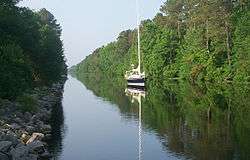Elizabeth City, North Carolina
| Elizabeth City, North Carolina | ||
|---|---|---|
| City | ||
|
Elizabeth City's Main Street | ||
| ||
| Nickname(s): Harbor of Hospitality® (registered by the city),[1] E.C., River City, Queen of the Albemarle, Betsytown | ||
|
Location in Pasquotank counties in the state of North Carolina | ||
| Coordinates: 36°17′44″N 76°13′30″W / 36.29556°N 76.22500°WCoordinates: 36°17′44″N 76°13′30″W / 36.29556°N 76.22500°W | ||
| Country | United States | |
| State | North Carolina | |
| Counties | Pasquotank, Camden | |
| Government | ||
| • Mayor | Elizabeth Malia | |
| Area | ||
| • City | 12.2 sq mi (31.7 km2) | |
| • Land | 11.6 sq mi (30.1 km2) | |
| • Water | 0.6 sq mi (1.6 km2) | |
| Elevation | 12 ft (4 m) | |
| Population (2010)[2] | ||
| • City | 18,683 | |
| • Estimate (2013)[3] | 18,266 | |
| • Density | 1,571/sq mi (606.6/km2) | |
| • Metro | 63,270 | |
| Time zone | EST (UTC-5) | |
| • Summer (DST) | EDT (UTC-4) | |
| ZIP codes | 27906, 27907, 27909 | |
| Area code(s) | 252 | |
| FIPS code | 37-20580[4] | |
| GNIS feature ID | 1025307[5] | |
| Website |
www | |
Elizabeth City is a city in Pasquotank County, North Carolina, in the United States. As of the 2014 census, it had a population of 18,047.[6] Elizabeth City is the county seat and largest city of Pasquotank County.[7] It is the cultural, economic and educational hub of the sixteen-county Historic Albemarle region of northeastern North Carolina.[8]
Elizabeth City is the center of the Elizabeth City Micropolitan Statistical Area, with a population of 64,094 as of 2010, and is part of the larger Virginia Beach-Norfolk, VA-NC Combined Statistical Area.[9] The city is the economic center of the region, as well as home to many historic sites and cultural traditions.
Marketed as the "Harbor of Hospitality", Elizabeth City has had a long history of shipping due to its location at a narrowed bend of the Pasquotank River.[10] Founded in 1794, Elizabeth City prospered early on from the Dismal Swamp Canal as a mercantile city, before later shifting into a varied industrial and commercial focus. While Elizabeth City still retains its extensive waterfront property, it is linked to neighboring counties and cities by highways and bridges and serves as the site of the largest US Coast Guard base in the nation.
History
Located at the narrows of the Pasquotank River, the area that would become Elizabeth City soon served as a trading site, and as early as the mid 18th century, inspection stations and ferries were established. With the addition of minor roads, a schoolhouse, and soon a church, a small community was established at these narrows.[11]
In 1793, construction of the Dismal Swamp Canal began, which would drive Elizabeth City's commerce, and the North Carolina Assembly incorporated the town of "Redding". In 1794, the town was renamed "Elizabethtown", but due to confusion with another town of the same name, in 1801, the city was renamed "Elizabeth City".[12] The name "Elizabeth" has been attributed to Elizabeth "Betsy" Tooley, a local tavern proprietress who donated much of the land for the new town.[13]
The improvements made to the Dismal Swamp Canal made Elizabeth City a financial center of trade and commercially successful for the early 19th century. In 1826, the federal government purchased 600 stocks in the canal and, in 1829, additional funds for improvements were raised by the Norfolk lottery. With these funds, the Dismal Swamp Canal was widened and deepened, allowing for larger boats to ship their goods.
Further bolstering Elizabeth City's financial success was the movement in 1827 of the customs house from Camden County to Elizabeth City. From only 1829 to 1832, Elizabeth City's tolls tripled. During the American Civil War the Confederate States had a small fleet stationed at Elizabeth City. After the Battle of Roanoke Island the Union forces sent a fleet to take the city. There was a small skirmish that followed which ended in a Union victory. Elizabeth City was under Union control for the remainder of the war, though Confederate irregulars engaged in guerrilla warfare with Union forces in the area for the remainder of the war.
Meanwhile, overland travel slowly improved, furnishing greater trade between neighboring counties, and a ferry continued to be used for transport between Elizabeth City and Camden County. However, the completion of competing canals and railroads around Elizabeth City diverted some of its financial success to neighboring cities. The Portsmouth and Weldon Railroad, completed in the 1830s, allowed for goods to be transported from the Roanoke River directly to Weldon, and the Albemarle–Chesapeake Canal, completed in 1859, created a deeper channel for merchants shipping goods from the eastern Albemarle Sound to Norfolk.
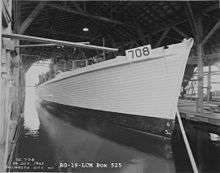
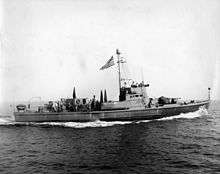
Such new opportunities established Elizabeth City as a thriving deep-water port whose varied industries as lumbering, shipbuilding, grain, fish and oyster processing, together once made the city a formidable regional economic center rivaling that of Norfolk, Virginia, and Baltimore, Maryland. With the 1881 establishment of the Elizabeth City and Norfolk Railroad, later renamed the Norfolk Southern Railway, water-based shipping was rendered less relevant, with many of the waterside industries relocating to the growing cities of North Carolina's Upper Coastal Plain and Piedmont.[14]
The declaration of World War II reinvigorated Elizabeth City's industries, particularly in shipbuilding, textiles and aeronautics. Establishment of Coast Guard Air Station Elizabeth City in 1940 as well as Navy Air Station Weeksville in 1941 provided valuable surveillance by seaplane and dirigible of German U-boats actively targeting American merchant shipping in East Coast waters. Additionally from 1942 to 1944, the Elizabeth City Shipyard manufactured thirty 111-foot SC-class submarine chasers,[15][16][17] four YT-class yard tugboats, and six 104-foot QS-class quick supply boats.[15][18] The Elizabeth City Shipyard not only built the largest number of subchasers for the war effort (30 out of 438 total), but also set the record construction time for the SC-class, with SC-740 laid down in only thirty days.[16] As of June 2013, the Elizabeth City Shipyard is still in operation.
The conclusion of the war led to a levelled economy as industry withdrew gradually over the following decades to form the service, government and agriculture-dominant economic sectors present today. Starting in the late 1990s, revival efforts in tourism and civic revitalization centered over downtown and the city's five historic districts have led to increasing economic stability.
The Elizabeth City Historic District, Elizabeth City State Teachers College Historic District, Elizabeth City Water Plant, Episcopal Cemetery, Norfolk Southern Passenger Station, Northside Historic District, Old Brick House, Riverside Historic District, and Shepard Street-South Road Street Historic District are listed on the National Register of Historic Places.[19]
Battle of Elizabeth City
During the Civil War, there was a small battle between the Confederate states and the Union near Elizabeth City on the Pasquotank River on February 10, 1862. It was nothing more than a skirmish and casualties were low. The battle ended in a Union victory with subsequent capture of the city.
Geography
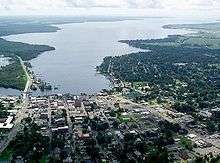
Elizabeth City is located alongside the Pasquotank River, which connects to Albemarle Sound. Directly across the river lies Camden County.
Elizabeth City is located at 36°17′44″N 76°13′30″W / 36.29556°N 76.22500°W (36.295585, −76.224954).[20]
According to the United States Census Bureau, Elizabeth City has a total area of 12.2 square miles (31.7 km2), of which 11.6 square miles (30.1 km2) is land and 0.62 square miles (1.6 km2), or 5.09%, is water.[6] Located in the "Inner Banks" region of North Carolina, Elizabeth City is largely flat and marshy with an elevation of only 12 feet (3.7 m) above sea level.[21] The city's semi-coastal geography has played an important role in its history—Elizabeth City once hosted thriving oyster and timber industries.
Climate
Elizabeth City has a humid subtropical climate, experiencing seasonal variation in temperature and precipitation. Due to its location, however, relatively close to the Albemarle Sound and the Atlantic Ocean, the temperature variations are somewhat softened. On average, Elizabeth City has its highest temperature and accumulation of precipitation in July. Elizabeth City commonly experiences thunderstorms during these summer months and has endured many tropical storms and hurricanes due to its proximity to the Atlantic Ocean. This city experiences very little snowfall, however, receiving on average a total of 3.5 inches (89 mm) of snow.[22]
| Climate data for Elizabeth City, North Carolina (1981–2010 normals) | |||||||||||||
|---|---|---|---|---|---|---|---|---|---|---|---|---|---|
| Month | Jan | Feb | Mar | Apr | May | Jun | Jul | Aug | Sep | Oct | Nov | Dec | Year |
| Average high °F (°C) | 50.9 (10.5) |
53.9 (12.2) |
60.7 (15.9) |
69.5 (20.8) |
76.8 (24.9) |
84.7 (29.3) |
87.5 (30.8) |
86.6 (30.3) |
81.2 (27.3) |
72.5 (22.5) |
64.0 (17.8) |
54.2 (12.3) |
70.2 (21.2) |
| Average low °F (°C) | 31.9 (−0.1) |
34.4 (1.3) |
39.6 (4.2) |
47.9 (8.8) |
56.7 (13.7) |
66.1 (18.9) |
70.0 (21.1) |
68.7 (20.4) |
63.1 (17.3) |
52.3 (11.3) |
42.2 (5.7) |
34.6 (1.4) |
50.6 (10.3) |
| Average precipitation inches (mm) | 2.56 (65) |
2.72 (69.1) |
3.49 (88.6) |
2.92 (74.2) |
4.00 (101.6) |
4.94 (125.5) |
4.97 (126.2) |
5.78 (146.8) |
4.55 (115.6) |
2.97 (75.4) |
3.02 (76.7) |
3.11 (79) |
45.03 (1,143.7) |
| Average snowfall inches (cm) | 1.4 (3.6) |
.5 (1.3) |
.7 (1.8) |
0 (0) |
0 (0) |
0 (0) |
0 (0) |
0 (0) |
0 (0) |
0 (0) |
.1 (0.3) |
.3 (0.8) |
3.0 (7.6) |
| Average precipitation days (≥ 0.01 in) | 8.6 | 8.9 | 9.7 | 9.1 | 10.8 | 10.1 | 11.8 | 10.8 | 9.1 | 7.7 | 7.9 | 9.5 | 114.2 |
| Average snowy days (≥ 0.1 in) | 0.7 | 0.3 | 0.2 | 0 | 0 | 0 | 0 | 0 | 0 | 0 | 0.1 | 0.2 | 1.5 |
| Source: NOAA[23] | |||||||||||||
Demographics
| Historical population | |||
|---|---|---|---|
| Census | Pop. | %± | |
| 1870 | 930 | — | |
| 1880 | 2,315 | 148.9% | |
| 1890 | 3,251 | 40.4% | |
| 1900 | 6,348 | 95.3% | |
| 1910 | 8,412 | 32.5% | |
| 1920 | 8,925 | 6.1% | |
| 1930 | 10,037 | 12.5% | |
| 1940 | 11,564 | 15.2% | |
| 1950 | 12,685 | 9.7% | |
| 1960 | 14,062 | 10.9% | |
| 1970 | 14,381 | 2.3% | |
| 1980 | 14,004 | −2.6% | |
| 1990 | 14,292 | 2.1% | |
| 2000 | 17,188 | 20.3% | |
| 2010 | 18,683 | 8.7% | |
| Est. 2015 | 17,988 | [24] | −3.7% |
| U.S. Decennial Census[25] 2013 Estimate[3] | |||
According to the 2010 U.S. Census,[4] there were 18,683 people, 7,487 households, and 4,689 families residing in the city. The population density was 1,607.0 people per square mile (4162.12/km2). There were 8,167 housing units at an average density of 702.24 per square mile (18.1879/km2). The racial makeup of the city was 39.50% White, 54.00% African American, 0.40% Native American, 1.20% Asian, 0.10% Pacific Islander, 0.62% from other races, and 2.30% from two or more races. Hispanic or Latino of any race were 5.00% of the population.
There were 6,577 households out of which 32.4% had children under the age of 18 living with them, 34.0% were married couples living together, 22.6% had a female householder with no husband present, and 38.6% were non-families. 32.8% of all households were made up of individuals and 27.9% had someone living alone who was 65 years of age or older. The average household size was 2.42 and the average family size was 3.01.
In the city the population was spread out with 27.7% under the age of 19, 12.1% from 20 to 24, 23.1% from 25 to 44, 22.1% from 45 to 64, and 13.9% who were 65 years of age or older. The median age was 31.3 years. For every 100 females there were 81.9 males. For every 100 females age 18 and over, there were 68.4 males.
The median income for a household in the city was $34,582, and the median income for a family was $41,071. Males had a median income of $31,307 versus $25,683 for females. The per capita income for the city was $17,592. About 21.6% of families and 28.1% of the population were below the poverty line, including 42.5% of those under age 18 and 12.1% of those age 65 or over. [26]
Government
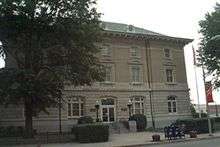
Elizabeth City serves as the county seat of Pasquotank County. The city has a council-manager style of government. The city council is composed of eight council members and the city manager, elected by the council members. The city manager serves a largely executive function, overseeing the city's administrative departments, appointing department heads and city employees, and informing the rest of the council of relevant municipal conditions. Currently, the city manager is Rich Olsen.[27] The eight council members, on the other hand, act in a legislative regard, adopting city policies, holding the city manager responsible, and choosing a mayor pro-tempore from its council members. This council is elected every two years by each of the four wards composing the city electing two members.[10]
The mayor, elected by the whole voter body every two years, also serves an executive function, serving as the head of a council meeting and casting a tie-breaking vote for the council. As of 2014, the mayor is Joseph Peel. Previous mayors include Charles L. Foster, who served from 2005 to 2007, and John Bell, who served from 1971 to 1981 and again from 2001 to 2005.[28]
The council holds its meetings every second and fourth Monday of the month; the meetings are rebroadcast on a public service channel.[10]
Elizabeth City has an office for the United States District Court for the Eastern District of North Carolina, headed by Terrence W. Boyle as the resident judge. This court presides over cases in the northern region of this district.[29]
Elizabeth City also occupies North Carolina's First Congressional District, served by US Representative G. K. Butterfield.[30]
U.S. Coast Guard
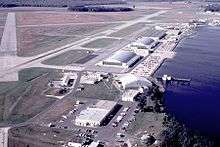
Established in 1940 and located southeast of Elizabeth City's corporate limits, Coast Guard Air Station Elizabeth City is the largest United States Coast Guard Air Station in the nation,[31] and home to six commands - Air Station Elizabeth City, Aviation Logistics Center, Aviation Technical Training Center, Base Elizabeth City, C-27J Asset Project Office (APO), and Small Boat Station Elizabeth City - as well as the off-base National Strike Force Coordination Center located in northern Elizabeth City. As a component of the United States Department of Homeland Security, the base, along with a host of defense contractors anchored by DRS Technologies, provide a host of local jobs and maintains an influx of Coast Guard and industry employees from all around the country.
The USCG Air Station and the Aviation Technical Training Center (ATTC) in Elizabeth City were featured in numerous scenes of the 2006 Disney movie The Guardian, standing in for Kodiak, Alaska.
Elizabeth City is home to one of the United States' few airship factories.[32] Many of the nation's commercial blimps are made and serviced here. The current airship facilities evolved from what had previously been Naval Air Station Weeksville, operational from 1941 to 1957. NAS Weeksville's LTA craft played a vital role in German U-boat spotting during World War II, helping to minimize losses to East Coast shipping.[33]
A joint public-private airpark adjacent to the Coast Guard base is in the planning stages. Intended to make Elizabeth City a premier hub of the aviation industry, the airpark hopes to attract major tenants as well as the Aviation Science programs of Elizabeth City State University and related programs by the College of the Albemarle.
Arts and culture
Elizabeth City is home to the Museum of the Albemarle, the northeastern regional branch of the North Carolina Museum of History. Located near the waterfront, the museum contains many permanent and revolving exhibits on the history and culture of the Albemarle region.
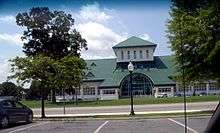
Pasquotank County has six National Register Historic Districts and six resources that are listed individually on the National Register, containing the state's largest concentration of antebellum-style homes and commercial buildings.
The Virginia Dare Hotel and Arcade, a neoclassical building designed in 1927 by William Lee Stoddart, continues to form the skyline of Elizabeth City and is listed in the National Register of Historic Places.[34] Adorned with a two-story arcade, the nine-story building is often known as the "first and only skyscraper of the Albemarle", and currently serves as an elderly apartment complex.[35]
Elizabeth City has been the birthplace of a few government officials in its history. Judge John Warren Davis, a justice on the Federal Court of Appeals, was born in Elizabeth City, as was John C. B. Ehringhaus, governor of North Carolina from 1933-1937 and for whom Ehringhaus Street, a major thoroughfare, is named.[14]
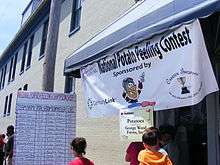
During the same era, nine-ball legend Luther Lassiter was born in Elizabeth City, and developed much of his skill at pool in the City Billiards pool hall.[36]
Elizabeth City was the 1929 birthplace of the American Moth Boat, a class of recreational sailboats invented by Dr. Joel Van Sant. The city hosts a Moth Boat Regatta annually in late February.[37][38] The Moth Boat features prominently on the city's seal.
North Carolina Potato Festival
Elizabeth City hosts the North Carolina Potato Festival, an annual celebration of the potato, one of the region's most important crops. The festival has steadily become one of the most popular draws in northeastern North Carolina, and is usually held in mid-May in downtown Elizabeth City.
Albemarle Craftsmans Fair
This annual Christmastime fair is sponsored by the Albemarle Craftsman's Guild and features artisans, many of whom wear period costumes, selling and demonstrating traditional crafts. Crafts include quilting and fiber arts, pottery, jewelry and woodwork.[39][40]
Juneteenth Celebration
This annual celebration is sponsored by River City Community Development Corporation and celebrates the freeing of African Slaves in America. It has evolved into a multi-racial, multi-cultural celebration of American Freedom. The festival features vendors and informational booths, speakers, entertainment and good food.
Shopping
Elizabeth City's shopping districts are generally centered on the Historic Downtown CBD, the Ehringhaus Street/US 17 Business strip, Hughes Boulevard/US 17, or the newest outgrowth, the City Center West/Halstead Boulevard Extended/Weeksville Road/NC 344 corridor.
- Historic Downtown Elizabeth City
Home to small Mom-and-Pop shops, lively local restaurants, charming art galleries, as well as government, financial and professional services.
- Ehringhaus Street (US
 Business)
Business)
The original alignment of US 17 through town, Ehringhaus Street became the business route in 1969 with the creation of US 17 Bypass (Hughes Boulevard). Ehringhaus Street is home to numerous familiar national and regional chain stores and restaurants, including those housed in Southgate Mall, the first and only enclosed shopping mall in northeastern North Carolina. Ehringhaus Street bridges the other shopping districts, connecting Downtown Elizabeth City at its eastern end to the Halstead and Hughes Boulevard corridors toward its western terminus. Major businesses along this corridor include at Southgate Mall Belk and Burke's Outlet; other chains include Panera Bread, Chick-Fila, Cook-Out, Wendy's, Bojangle's, Hardee's, Pizza Hut, Taco Bell, Burger King, McDonald's, Sonic Drive-In, Walgreens, CVS, Food Lion, Lowe's, Ollie's Bargain Outlet, Dollar Tree, Family Dollar, AutoZone, Advance Auto Parts, NAPA Auto Parts and Chevrolet.
- Hughes Boulevard/North Road Street (US
 )
)
Formerly US 17 Bypass skirting the city, failure by NCDOT to secure adequate right-of-way along the then-new route led to business growth and traffic constriction, the latter exacerbated by a 2002 decision to install a center turning lane without physical widening of the roadbed. The business community is an eclectic mix of local shops and national chains, the latter service sector-dominant, such as motels, restaurants and gas stations. Major businesses along this corridor include Comfort Inn, Days Inn, Quality Inn, Ruby Tuesday, Applebee's, Wendy's, Arby's, Hardee's, Burger King, KFC, Subway (2), McDonald's, Dollar General (2), Farm Fresh, Food Lion, Big Lots, Carquest Auto Parts, Ford, Nissan and Hyundai.
- Halstead Boulevard Extended/Halstead Boulevard/Weeksville Road (NC
 )
)
Connecting US 17 Bypass to Elizabeth City is the relatively new corridor of Halstead Boulevard Extended, a route co-established with the bypass' creation in 2002. In the past decade, Halstead has been the fastest-growing section of the city, drawing both relocating businesses from elsewhere in town as well as entirely new tenants, the majority of which are national chains. Major businesses along this corridor include Walmart Supercenter, TJ Maxx, Ross Dress for Less, Hobby Lobby, Dollar Tree, Rack Room Shoes, Petsense, Rue21, Fairfield Inn by Marriott, Hampton Inn, Best Western, IHOP, Subway, McDonald's, Zaxby's, At&t wireless, Verizon, Rose's, Dollar General, Food Lion, Tractor Supply, Honda, Toyota and Chrysler.
Media
The Daily Advance has served as Elizabeth City's sole daily newspaper since its founding by Herbert Peele in 1911.[41] In mid-2009, the Daily Advance was bought by Cooke Communications.[42]
The Independent was a weekly newspaper serving Elizabeth City and the surrounding Albemarle area from 1908 to 1939. The Independent was published by William Oscar "W.O." Saunders (1884-1940).[43]
Elizabeth City is part of the Hampton Roads television market. The majority of the stations received in the area come from southeastern Virginia, including WTKR (CBS), WAVY (NBC), WVEC (ABC), WVBT (FOX), and WHRO (PBS).
The only exceptions are WUND (PBS), a repeater transmitter of UNC-TV licensed to broadcast from Edenton, North Carolina, and WSKY (independent) transmitting from Camden. The only station based in Elizabeth City is W18BB-D, broadcasting from a tower on the Elizabeth City State University campus.
Education
All public education is overseen by the Elizabeth City-Pasquotank County School Board of Education under the Elizabeth City-Pasquotank Public School system (ECPPS) which operates seven elementary schools, two middle schools, two high schools, and one alternative high school.[44]
Elementary schools
- Central Elementary
- J.C. Sawyer Elementary
- Northside Elementary
- Pasquotank Elementary
- P.W. Moore Elementary
- Sheep-Harney Elementary
- Weeksville Elementary
Middle schools
- Elizabeth City Middle
- River Road Middle
High schools
Alternative school
- H.L. Trigg Alternative
Private schools
- Albemarle School
- Cathedral Christian Academy
- Foreshadow Academy
- Grace Montessori Academy
- New Life Academy
- Victory Christian School
Higher education
Elizabeth City is home to one private and two public institutions of higher education.
Elizabeth City State University, the smallest constituent member of the 16-campus University of North Carolina System, is a historically African-American institution, enrolling 2,930 students as of fall 2011[45] on a compact 200-acre (0.81 km2) campus along the city's southern edge. Founded as a normal school in 1891, it now serves the higher educational needs of northeastern North Carolina's sixteen counties, offering 37 undergraduate and four master's degrees.[46]
ECSU offers Aviation Science programs at their training facility at Elizabeth City Regional Airport,[47] as well as a Doctor of Pharmacy (PharmD) program in collaboration with the University of North Carolina at Chapel Hill (UNC-CH), flagship school of the UNC system.[48]
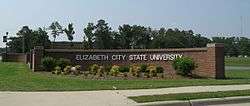
Also located here is the main campus of the College of the Albemarle, positioned on the city's northern edge adjacent to Albemarle Hospital. It is known as the first community college to be established under the (North Carolina) Community College Act of 1960. COA has satellite campuses in Barco, Edenton and Manteo.[49]
Mid-Atlantic Christian University, a private Christian institution founded in 1948, is located along the Pasquotank River north of downtown Elizabeth City.
All three schools have agreements allowing students to dual-enroll in one of the other two institutions.
Healthcare
The primary healthcare provider in Elizabeth City is Sentara Albemarle Medical Center, a 182-bed regional medical center and part of the Sentara Healthcare system. Owned and formally operated by Pasquotank County, Albemarle Hospital has been in operation since 1914,[50] relocating to its current location in 1960.[51] In 2008, the Albemarle Health system came under the day-to-day management of Greenville-based Vidant Health, although ownership and most executive decisions remained with the county.
Starting in October 2012, the county began soliciting offers for affiliation with neighboring healthcare systems in order to cement Albemarle Hospital's position as the region's major medical facility. Limitations in some services and speciality providers had caused many prospective patients to seek services in the Hampton Roads or Greenville metro areas, leading to steady erosion of operating margins. Affiliation with a larger health organization would also provide increased buying power, improvements in equipment and facility investment as well as entice additional physicians to the area.[52]
By January 2013 the board had received strong offers from then-current manager Vidant Health as well as Norfolk-based Sentara Healthcare and Brentwood, Tennessee-based Duke-LifePoint Health, itself a partnership between Durham-based Duke University Health System and Brentwood-based LifePoint Hospitals.[53]
A 100-year management agreement for operation of the Albemarle Health system was reached with Sentara Healthcare, becoming effective on 1 March 2014, with Sentara committing to streamline patient care as well as make substantial investments in the physical building itself.
Services and utilities
As part of its municipal mandate, Elizabeth City operates full-service police (ECPD), fire (ECFD) and public housing departments as well as water, sewer, sanitation and electric divisions which operate several deep wells, a water purification plant, three water towers, and a combined sewage/wastewater treatment plant.[54] The city cooperates with Pasquotank County in joint operation of the Elizabeth City-Pasquotank Parks and Recreational Department (ECPPRD), Department of Social Services (ECPDSS), and the Witherspoon Memorial Library, the largest facility and head office of the four-county East Albemarle Regional Library System.[55]
As with other Albemarle-area municipalities, Elizabeth City purchases wholesale electricity from Dominion North Carolina Power, operating 230kV transmission lines through the Albemarle area.[56] Electricity is generated from coal-fired and nuclear power plants in nearby Chesapeake and Surry, Virginia, respectively.[57]
Local telephone service is currently provided by CenturyLink, operating out of the former headquarters and switchboard exchange building of early Elizabeth City-based provider Norfolk and Carolina Telephone and Telegraph.[58] N&CT&T was later succeeded by Carolina Telephone & Telegraph, United Telecom, Sprint and Embarq.
Cable television and Internet is provided by Time Warner, previously Adelphia Communications.
Pipeline natural gas is provided by Piedmont Natural Gas. Tank and bottled gas are also available through several local suppliers.
Transportation
Highways
Elizabeth City is linked to neighboring counties and cities through a network of highways.
Most unusual are the four branches of U.S. Route 17 that pass through the city - rarely are there more than two or three variants of the same route in any given community.
Mainline U.S. Route 17 crosses the Little River, entering Pasquotank County from the southwest. Bypass US 17 immediately splits off to the northwest as mainline US 17 continues to the northeast toward Elizabeth City. Shortly after entering the city limits, US 17 Business splits off to the east towards the downtown waterfront. Mainline US 17 continues through Elizabeth City as Hughes Boulevard (the former US 17 Bypass from 1969 to 2002).
The route encounters major intersections with the commercial corridor of NC 344 (Halstead Boulevard), Church Street, Main Street and midway by Elizabeth Street, where it is joined by US 158 and Truck Business US 17. This tri-route combination continues northeastward to Business 17 and Truck Business 17's northern termini at the intersection with North Road Street. From here, mainline US 17 and 158 make a curve to the northwest, departing Elizabeth City as a continuance of North Road Street.
Bypass US 17 rejoins the highway several miles outside of town, while US 158 splits off to the west at Morgan's Corner just before crossing the Pasquotank River into Camden County. Running parallel to the Dismal Swamp Canal and the eastern boundary of the Great Dismal Swamp, US 17 continues to the Virginia border.
U.S. Route 17 Business (1969–present) branches off Hughes Boulevard and travels east as Ehringhaus Street, named for Governor John C. B. Ehringhaus (1933-1937), the only governor native to Elizabeth City. The route turns north through Downtown as North Road Street, ending with its intersection with US 17/Hughes Boulevard. Mainline US 17 continues north on North Road Street.
U.S. Route 17 Truck Business is a double designation almost unique among U.S. routes, traveling from the Camden Causeway west along Elizabeth Street and north along Hughes Boulevard to double-terminate with US 17 Business. The northern segment of US 17 Business from Elizabeth Street to its termination at Hughes Boulevard runs through a residential district and additionally has weight restrictions, thus requiring an alternate business routing.
The last and newest branch is U.S. Route 17 Bypass, a fully access-controlled and Interstate-grade freeway. Completed in 2002 to the immediate west of the city, the bypass eliminated one of the last remaining inner-city stretches of US 17 in North Carolina.
U.S. Route 158 enters Elizabeth City from points east, including the Outer Banks, as well as Dare, Currituck, and Camden counties. Traveling westward through town as Elizabeth Street, US 158 temporarily merges with mainline and Truck Business US 17, traveling northwestward before diverging at Morgan's Corner and continuing westward across the Great Dismal Swamp into Gates County.
North Carolina Highway 344 forms a minor connection southeastward from the US 17 Bypass to southern Pasquotank County. NC 344 serves as a major commercial and industrial corridor along Elizabeth City's southern edge, providing access to Coast Guard Air Station Elizabeth City, Elizabeth City State University, and the rural unincorporated community of Weeksville.
Air
Elizabeth City has a joint civil-military airport, shared with U.S. Coast Guard Air Station Elizabeth City, and located 4 miles (6 km) southeast of the city limits, named the Elizabeth City Regional Airport (IATA: ECG, ICAO: KECG, FAA LID: ECG).
Scheduled domestic and international passenger services are available at Norfolk International Airport (IATA: ORF, ICAO: KORF, FAA LID: ORF), located about an hour north in Norfolk, Virginia.
Bus
Local public bus transportation is provided by the Inter-County Public Transportation Authority (ICPTA), with service to Pasquotank, Perquimans, Camden, Chowan, and Currituck counties.[59]
Elizabeth City has regularly scheduled inter-city bus service through Greyhound.
Rail
The Chesapeake and Albemarle Railroad, a short line operated by the North Carolina and Virginia Railroad, extends 82 miles (132 km) between Edenton, North Carolina, and Chesapeake, Virginia. This line had first been established in 1881 as the Elizabeth City and Norfolk Railroad, later renamed the Norfolk Southern Railway. Once one of Norfolk Southern's principal lines, the decline of the region's industry and the demolition of tracks across the Albemarle Sound from Edenton to Mackey's Ferry marginalized the route, forcing the line's lease to the Chesapeake and Albemarle in 1990.[60] The railroad still serves the region, primarily carrying grain, sand, gravel and other raw materials to and from the Norfolk Southern and CSX mainlines in Chesapeake.
Passenger service to Elizabeth City ended in 1947. Today, the closest passenger service is provided by Amtrak in Newport News, Virginia, approximately one hour to the north. Though an Amtrak station exists in Norfolk, Virginia, most outbound passengers from Norfolk are bussed via Amtrak Connect to Newport News instead.
Notable residents
- John Warren Davis (1867-1945) was born in Elizabeth City and went on to become a federal judge and a New Jersey politician.
- John C. B. Ehringhaus (1882-1949), an Elizabeth City native, was the first and only Elizabeth Citian to serve as North Carolina governor (1933-1937).
- Alex Haley (1921-1992), the author of the 1976 book Roots. Though not an Elizabeth City native, he spent his second year of college at Elizabeth City State College (now Elizabeth City State University) in 1937.
- Luther "Wimpy" Lassiter (1918-1988) was a world-renowned nine-ball pool player and an Elizabeth City native. His pool playing skills were perfected at the former City Billiards hall in downtown Elizabeth City.
- Scotty McCreery (born 1993) is a current country music singer and native of Garner, North Carolina, whose grandmother is an Elizabeth City resident.[61] McCreery has an exhibit dedicated to his musical career at the Museum of the Albemarle, the northeastern branch of the North Carolina Museum of History, in Elizabeth City.[62]
- James W. Owens (born 1946) is an Elizabeth City native as well as former chairman and CEO of Caterpillar Inc. (2004-2010).
- Max Roach (1924-2007) was a nationally-known jazz percussionist, drummer and composer. Roach was born in the northern Pasquotank County township of Newland north of Elizabeth City.
- Cecil Rouson (born 1962) was an Elizabeth City native as well as NFL running back for the New York Giants and the Cleveland Browns.
- Edward Snowden (born 1983) was revealed in June 2013 as an NSA whistleblower, leaking classified government documents to The Guardian newspaper of Britain. Snowden spent part of his childhood growing up in Elizabeth City.[63][64]
- Barbra Lassiter (1933-2012) was born in Elizabeth City. Married to Luther "Wimpy" Lassiter's brother Clarence Doyle Lassiter.
See also
- Albemarle Hospital
- Coast Guard Air Station Elizabeth City
- College of the Albemarle
- Elizabeth City State University
- Moth (dinghy)
- Museum of the Albemarle
- Southgate Mall (Elizabeth City)
- Weeksville Dirigible Hangar
References
- ↑ "Harbor of Hospitality". USPTO. Retrieved 16 April 2013.
- ↑ "American FactFinder". United States Census Bureau. Retrieved 2014-10-17.
- 1 2 "Population Estimates". United States Census Bureau. Retrieved 2014-10-17.
- 1 2 "American FactFinder". United States Census Bureau. Retrieved 2011-05-14.
- ↑ "US Board on Geographic Names". United States Geological Survey. 2007-10-25. Retrieved 2008-01-31.
- 1 2 "Geographic Identifiers: 2010 Demographic Profile Data (G001): Elizabeth City city, North Carolina". U.S. Census Bureau, American Factfinder. Retrieved December 19, 2014.
- ↑ "Find a County". National Association of Counties. Retrieved 2011-06-07.
- ↑ "City Data". City Data. Retrieved July 14, 2016.
- ↑ "Geographic Identifiers: 2010 Demographic Profile Data (G001): Elizabeth City, NC Micro Area; North Carolina". U.S. Census Bureau, American Factfinder. Retrieved December 19, 2014.
- 1 2 3 http://www.cityofec.com/index.asp?Type=B_BASIC&SEC={9F89997F-1F28-4877-AD0C-87869AE09C04}
- ↑ http://www.historicelizabethcity.org/text/1.1.html
- ↑ http://www.historicelizabethcity.org/text/1.2.1.html
- ↑ http://www.carolina-north.com/elizabeth_city.html
- 1 2 http://www.historicelizabethcity.org/text/1.6.3.html
- 1 2 http://shipbuildinghistory.com/history/shipyards/4emergencysmall/elizabeth.htm
- 1 2 http://www.splinterfleet.org/sfspec.php
- ↑ http://www.navsource.org/archives/12/01idx.htm
- ↑ http://shipbuildinghistory.com/history/smallships/armyqsboats.htm
- ↑ National Park Service (2010-07-09). "National Register Information System". National Register of Historic Places. National Park Service.
- ↑ "US Gazetteer files: 2010, 2000, and 1990". United States Census Bureau. 2011-02-12. Retrieved 2011-04-23.
- ↑ http://www.cityofec.com/index.asp?Type=B_BASIC&SEC={2A61F98E-FB96-4A6A-BDF1-DA36B3E75800}
- ↑ http://www.weatherbase.com/weather/weather.php3?s=010337&refer=
- ↑ "NowData - NOAA Online Weather Data". National Oceanic and Atmospheric Administration. Retrieved 2013-06-28.
- ↑ "Annual Estimates of the Resident Population for Incorporated Places: April 1, 2010 to July 1, 2015". Retrieved July 2, 2016.
- ↑ United States Census Bureau. "Census of Population and Housing". Retrieved October 17, 2014.
- ↑ http://factfinder2.census.gov/faces/tableservices/jsf/pages/productview.xhtml?pid=DEC_10_DP_DPDP1&prodType=table
- ↑ http://www.cityofec.com/index.asp?Type=B_BASIC&SEC={28B2A46B-BABB-4694-B9FF-CE3F092AD426}
- ↑ Bob Montgomery (December 10, 2005). "Departing EC mayor proud of city's growth". Daily Advance. Retrieved December 17, 2014.
- ↑ http://www.nced.uscourts.gov/html/divoffElizabethCity.htm
- ↑ http://butterfield.house.gov/index.cfm?sectionid=73
- ↑ "United States Coast Guard Complex". Visit NC.
- ↑ http://www.tcomlp.com/facilities.html
- ↑ http://www.elizcity.com/weeksnas/
- ↑ http://www.hpo.ncdcr.gov/nr/CT1080.pdf
- ↑ http://www.historicelizabethcity.org/tour/VirginiaDareHotel.html
- ↑ "Shooting Out The Lights With Wimpy". CNN. 16 October 1967.
- ↑ http://www.mothboat.com/
- ↑ http://www.mothboat.com/schedule.html
- ↑ Albemarle Craftsmans Fair
- ↑ Albemarle Craftsmans Fair
- ↑ http://advance.cookecomm.net/customer-service/old-friend-comes-you-new-way-13384
- ↑ http://www.witn.com/northeasternnorthcarolina/headlines/51241047.html
- ↑ Saunders, Keith. The Independent Man. Edwards and Broughton; [S.I.] : Saunders Press, 1962, p. 1.
- ↑ http://www.ecpps.k12.nc.us/
- ↑ http://www.ecsu.edu/administration/ia/urm/quickfacts.cfm
- ↑ http://www.ecsu.edu/academics/index.cfm
- ↑ http://www.ecsu.edu/fs/docs/VSA07Final.pdf
- ↑ http://www.ecsu.edu/academics/mathsciencetechnology/pharmhealthpro/index.cfm
- ↑ http://www.albemarle.edu/welcome.php?cat=486
- ↑ http://www.albemarlehealth.org/about-us/our-history/
- ↑ Albemarle Hospital
- ↑ http://ahfuture.org/faqs/
- ↑ http://ahfuture.org/wp-content/uploads/2012/10/Request%20for%20Proposals%20for%20Affiliation%20Arrangement%20for%20Albemarle%20Health.PDF
- ↑ http://www.cityofec.com/index.asp?Type=B_BASIC&SEC={70BA7A92-FBB5-478B-A9AF-5D4873DFEB9F}
- ↑ http://www2.youseemore.com/earl/directory.asp
- ↑ https://www.dom.com/about/electric-transmission/winfall/pdf/existing-structures.pdf
- ↑ https://www.dom.com/about/stations/index.jsp
- ↑ http://www.kadiak.org/joe/nctt/cos.html
- ↑ http://www.icpta.net/about/
- ↑ http://www.norfolksouthernhs.org/briefNShistory.html
- ↑ http://www.billleslie.com/apps/blog/show/7115556
- ↑ http://news.ncdcr.gov/2013/01/15/american-idol-winner-scotty-mccreery-exhibit-at-the-museum-of-the-albemarle/
- ↑ "Edward Snowden: the whistleblower behind the NSA surveillance revelations". The Guardian. 10 June 2013.
- ↑ http://usnews.nbcnews.com/_news/2013/06/09/18865637-i-will-be-made-to-suffer-for-my-actions-self-identified-source-for-nsa-leaks-comes-forward?lite
External links
| Wikimedia Commons has media related to Elizabeth City, North Carolina. |
| Wikivoyage has a travel guide for Elizabeth City. |
- Official website
- Elizabeth City Area Convention & Visitors Bureau
- Elizabeth City Area Chamber of Commerce
- Designated Historic Districts in Elizabeth City
- Port Discover: Northeastern North Carolina's Center for Hands-On Science

